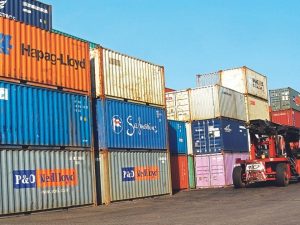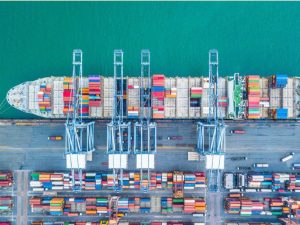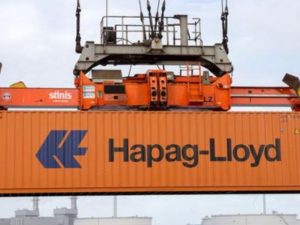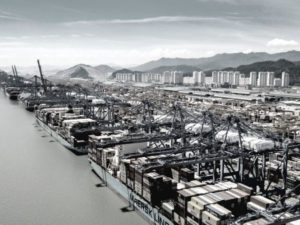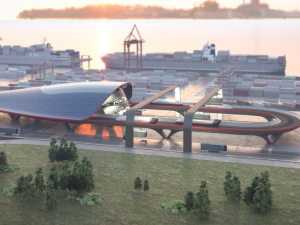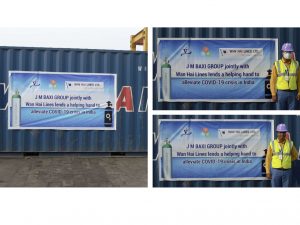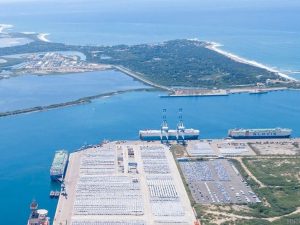Jawaharlal Nehru Port Trust (JNPT), one of the premier container handling ports, recorded 433,533 TEUs in July 2021 compared to 344,316 TEUs in July 2020, a growth of 21.15% as compared to the same period last year. The container traffic handled at JNPT during the first 4 months of FY 2021-22 was 1,797,838 TEUs as against 1,192,165 TEUs, which is 50.80% higher than the container traffic over the same period of last year. In terms of rail operations, JNPT handled 77,662 TEUS of ICD traffic from 503 rakes in July 2021, and the Rail-Coefficient was 17.91%. To enhance the model shift from road to rail, JNPT is undertaking a host of initiatives like the commencement of rail service between JNPT and Balli (in South Goa) on the Konkan Railway, and other initiatives like ITRHO has helped to maximize train placement, track productivity, efficiency, cost-effective handling, reduce dwell time of import ICD boxes, connecting export ICD boxes to respective terminals in time and also increase rail quotient at JNPT.
Read More »Container manufacturing yet to catch up with demand
The world’s largest container-equipment leasing company, Triton International (NYSE: TRTN), announced record results and provided the latest intel on box production. The price of a new container, which had stabilized at around $3,500 per twenty-foot equivalent unit (TEU) earlier this year, has risen again and is now at $3,800 per TEU. Prices are “at unprecedented levels,” said John O’Callaghan, Triton’s global head of marketing and operations, during the call with analysts. The price of a new container at this time two years ago, pre-COVID, was around $1,600 per TEU, less than half the current level. What’s particularly telling is that the price is rising at the very time Chinese factories are churning out more new boxes than they ever have before. According to Triton’s estimate, which excludes sales to nonleasing and nonshipping buyers, factories built around 2.6 million TEUs of dry (nonrefrigerated/nontank) containers in H1 2021 — more than the 12-month totals in most years.
Read More »DSV Panalpina releases financial report for first-half of 2021
DSV Panalpina releases the interim financial report for the first six months of 2021. The results show strong growth in EBIT before special items of 64, 7 percent during the first six months of 2021 compared to the same period in 2020. The great performance was driven by 18 percent growth in gross profit and a high productivity across all divisions. Jens Bjørn Andersen, Group CEO, “We are proud to report strong results for the first six months of 2021, where we deliver an EBIT result equivalent to our full-year EBIT of 2019. This is a clear testament to the successful integration of Panalpina and a strong performance by our organisation in an extraordinary market environment. The logistics markets continue to be characterised by tight capacity, congestion and low visibility.
Read More »Hapag-Lloyd suspends bookings to Bangladesh
Hapag-Lloyd, a German container shipping company, has decided to suspend its booking of import containers bound for Bangladesh via Singapore for a month. The container transportation company announced on June 24 that bookings for cargo moving into Bangladesh via Singapore would not be possible for the next four weeks due to an increased backlog of containers destined for Chattogram at the transhipment port. However, the decision is not applicable for export bound containers from Bangladesh, said Abul Kalam Azad, general manager of operations at GBX Logistics, the local agent of Hapag-Llyod. “Hapag-Llyod was forced to take such a decision after facing a huge pile up of its Bangladesh-bound import cargo at Singapore port, which is choking with congestion,” Azad said. More than 3,500 Bangladesh-bound import containers being carried by the company are now sitting idle in Singapore. This situation was caused by the increased number of import containers heading for Chattogram and reduced transport capacity among feeder operators.
Read More »Shipping lines skip Busan due to capacity issues
South Korea’s Ministry of Oceans and Fisheries said that liner operators have been omitting calls to Busan, reportedly because Chinese shippers are more willing to pay higher freight charges. Citing data from Busan Port Authority, the ministry said that from the beginning of this year to 10 July, 6,767 container ships entered the country’s busiest container port, a decrease of about 700 (9%) compared to the same period last year. THE Alliance, comprising Hapag-Lloyd, ONE, Yang Ming and HMM, is among those skipping Busan. From 19 July to 15 August, the alliance’s MD2 Asia-Mediterranean service will not stop at Busan. To maintain schedule reliability and prioritise container allocation, liner operators have been skipping ports that are perceived to be less important, said Linerlytica analyst Tan Hua Joo, who told Container News that the situation is not unique to Busan. Chinese ports Qingdao and Tianjin have also been affected, even though Tianjin is the main port serving Beijing.
Read More »Hyperport, heralding a new era in container transportation
HyperPort is a sustainable high-speed cargo and freight solution which is capable of increasing capacity and efficiency while also keeping a check on the pollution and congestion at ports worldwide. The system which is developed in partnership with terminal operator Hamburg Hafen und Logistik AG, is said to be going into certification design review. At present, as part of its short term concept, the companies are developing a VR demonstrator that will be presented at the ITS World Congress in Hamburg later this year from October 11-15. Engineered to current industry standards, the new concept is a plug-n-play solution for port operators who are capable of transporting containerised cargo hundreds of kilometres away, in minutes. It will be capable of sustainably moving 2,800 containers per day at speeds of up 600 km/h (327 mph). The new system is considered to give the Airplane speed at the price of freight cost. It is potentially two or three times faster than high-speed rail and has 10 times the speed of regular rail services. Also, it is more energy efficient as the track doesn’t need to provide power to the pods continuously. Furthermore, the pods can leave every 30 seconds, and this makes it an on-demand service. Such exceptional speed makes it very well in sync with the changing consumer demand and the rising concept of same day deliveries.
Read More »Container shortage hits Indian exporters
Foreign buyers have started cancelling the shipments boarding from India because the exporters are not able to avail any containers leading to consignments lying at various ports for weeks together. This, coupled with ever-soaring freight rates and congested ports, has left the small-time exporters of India fighting for every penny as the freight rates are higher than the cost of their product. Container News spoke with the Managing Director of the New Delhi-based clothing manufacturer, Jyoti Apparels, HKL Magu, who said that “high freight rates can be absorbed, but unavailability of containers has changed the rules of the game. Several vessels are bypassing India because there are no containers for consignments to be shipped. Sometimes our consignments are lying in ports for three to four weeks. International buyers tell us to either cancel the order or send it by air. But air freight rates have also skyrocketed”.
Read More »JMB extends help with Oxygen Cylinders
The exponential surge of coronavirus infection over the past few weeks has swamped the health care system that witnessed patients facing many challenges in getting oxygen at the right time thus resulting in lots of deaths at various situations. The dire shortage has turned out to be a major challenge faced by hospitals in many states across the country. Several healthcare centres in Indian cities and towns have run short of the gas leaving the people helpless. Recently JM Baxi Group had supplied Oxygen Cylinders to the states of Delhi, Andhra Pradesh and Maharashtra. At the time of extreme crises faced again across the country JM Baxi has once again extended its hands to help the needy in the imports of oxygen cylinders through Visakha container Terminal. The imports are done by WAN HAI lines that brought 14×20’ of oxygen laden cylinders from Qingdao & 25×20’ of empty cylinders on their service “m.v. TRF Kaya” arrived Visakhapatnam Port on 09th July. The unconditional support from the shipping fraternity in carrying these oxygen cylinders across the country is truly commendable. Despite the challenges of the lockdown VCT also continued to render its services through the able support of all the concerned stakeholders.
Read More »Hambantota Port increases bulk handling
The Hambantota International Port (HIP) recorded their highest discharge levels of bulk cargo recently, when a shipment of gypsum consigned to Insee Cement was unloaded at a rate of 24,000 Metric tons per day by port operations. Thusith Gunawarnasuriya, Director Procurement & Logistics of Insee Cement says this was an extraordinary achievement for a Sri Lankan port in terms of speed and efficiency. “As the No. 1 cement manufacturing company in Sri Lanka, we import raw materials in large vessels. But once these vessels arrive in the country, it is up to port operations, in this case HIPG and HIPS, to discharge the vessels quickly. Quicker the cargo is discharged, the more benefit not only to us but also the country because for each day the vessel remains in port we pay vast amounts in detention and demurrage —something to the tune of US $ 75,000. Therefore, when we are able to discharge two-and-a-half days earlier like we did this time, the cost saving is significant. Yes, it is an advantage for our company, but it is also a considerable saving in foreign exchange for the country.”
Read More »Trusted technology for shipping lines and shipyards
AVEVA offers a complete suite of technology solutions that enable shipyards become more agile, while shipping lines can better share and analyse data from ship to shore, explains Herve Lours, Vice President – Marine, AVEVA. It is a $1.6 billion software company listed on the London Stock Exchange. It’s a leader in industrial software business, primarily focusing on gas, power and marine. AVEVA is also one of the largest software companies in the maritime sector and has some unique capabilities – this is the only software supplier in the maritime world providing a complete software suite for the entire lifecycle, starting from engineering design and moving down to operations of the shipyard and ships as well. Talking about the lifecycle, engineering and design, AVEVA is a leader in this area, with an approximate 60% market share in engineering and design software, which means we are active in most of the important shipyards. AVEVA is also the leader in the shipping sector, providing solutions to ship owners, system integrators and more than 3000 ships are using AVEVA software on-board.
Read More » Cargo Breaking News
Cargo Breaking News

